Magic Island and Atlantis-Dumaguete, PhilippinesContents of this Issue: Magic Island and Atlantis-Dumaguete, Philippines What’s With All the Photo Bullies? Belize, British Virgin Islands, Hawaii To Avoid Hypothermia, Divers Should Stay “in the Hood” What’s to Become of Jacques Cousteau’s Calypso? No Two Dive Computers Are Alike Two Good Reads for Reducing Your Dive Risks Don’t Count on Getting That Dive Trip Deposit Back How Do You Handle a Bully on the Boat? Regulator-Ripping Diver Sentenced in Underwater Attacks Petit Mustique, St. Vincent and the Grenadines Editorial Office: Ben Davison Publisher and Editor Undercurrent 3020 Bridgeway, Suite 102 Sausalito, CA 94965 creature comforts, incredible sea life, affordable prices from the April, 2015 issue of Undercurrent
Dear Fellow Diver: After a lifetime of hemming and hawing about whether the trek would be worth the effort, I selected the Philippines because I wanted to see the unusual critters of the Indo-Pacific and, going that far, I wanted to stay a week each in two different venues without breaking the bank. I wanted good accommodations, good food, good people. I got it all, and I think you can, too. Frankly, however, getting there is not half the fun, expecially if you change planes. Sipping my welcome drink (it should have been a good-night toddy) at 2:30 a.m. at Magic Island seemed a bit out of sorts -- my partner and I transferred in Seoul and flew directly to Cebu City, where we were met at midnight by a van for the twohour trip to the 10-cabin resort near Moalboal. I quickly discovered that the gain far outweighed the pain. After the very first dive the next day, I tried not to get too excited while reviewing my photos. On my house reef checkout dive, hundreds of hydra-tentacled Lampert's sea cucumbers swarmed on blue sponges. Clusters of soft Xxenia coral pulsed madly. An olive Ridley sea turtle swam by, pausing to munch on a sponge. Messmate pipefish were foraging vigorously. And 15 minutes into my second dive, my guide showed me one of the crown jewels: a pygmy seahorse.
Most of Magic Island's 10 cottages, with woven walls and wood floors, offer small front porches overlooking the Strait of Tanon; the others overlook a nice swimming pool. The louvered windows and shrubbery made for plenty of privacy. Simple furnishings included a king bed with nightstands, and a desk large enough to work for my camera workstation. A small bathroom and shower had plenty of hot water. The compact dive center had a well-ventilated gear area and a separate room with rinse tubs, boat assignments and illustrated dive briefings. Outside, divers could rinse off and hang gear on a roomy open patio. Staggered departure times meant only one group of four to six divers needed to suit up at once. Magic Island had three beautiful, white, outboard-powered outrigger bankas, each narrow and about 40 feet long. The crew loaded gear on board and changed everything over between dives. Entry was by backroll, exit by climbing the ladder after handing up weights, BCs and fins to a divemaster.
Every dive brought the unusual. At Eyoy Point, the brown, hairy, long, apelike "arms" quickly identified an orangutan crab. After one lunch on a beach, we did a drift dive through an enormous bait ball of sardines. On a night dive at Pescador Island, I spotted many species of unusual lionfish and scorpionfish. After I referred to my ID book, I learned a green moray was in fact a fimbriated moray -- its dark splotches made the differences between similar species. I felt like Charles Darwin contemplating the theory of evolution. Regardless of the unique critters, be forewarned. A fish longer than a snorkel is rare. Small outriggers filled with subsistence fishermen lined the wall. At low tide, people walked on the exposed reef, gathering any edible creatures they could find. The contrast between the lean bodies of locals and the ample figures of many of the resort's guests spoke volumes. As did the food they consumed, myself included. Breakfasts started with rich coffee and perhaps a banana smoothie or fresh orange juice. I was a sucker for the buttery, slow-cooked ham, cheese and mushroom omelet. My group opted to have lunches and dinners served family style (go without a group and order off the menu), so dinners were kicked off by plates of appetizers like shrimp kebabs, followed by plates of delicious grilled tuna steak or dorado simmered in wine sauce, chicken (from curry to Florentine style), beef or pork. Vegetables included simple garden salads and beans. Tropical fruits such as sliced mango were often served. During the meals, I enjoyed the malty San Miguel Cerveza Negra, and, if I could handle it, a dessert such as "mocha magnifico," a nut-encrusted layered concoction dusted with cocoa powder. The meals offered by Magic Island occurred in a variety of locations that join the local culture. For example, during the ribbon-cutting ceremony for Magic Island's fourth banka, we were treated to a lunch of grilled whole fish, rice, and salad at a nearby beach, where local women offered beach wraps, necklaces and carved items for sale. I came away with $5 worth of small wooden sea turtles as gifts. Not everything goes well for everyone on a dive trip, unfortunately. A serious and skilled photographer in my group lost several diving days when his wife inadvertently poked him in his (one good) eye. It became infected, and after seeing a local doctor, he stayed in his darkened cottage for the next three days. It was fortunate that his marriage is a good one. On the last day of my stay at Magic Island, I enjoyed an excursion to Kawasan Falls, passing a landscape steeped in the culture of another world, including flooded rice fields and ponds dedicated to aquaculture. People crouched on their haunches, tending small fires next to their small bamboo homes. Kawasan Falls was a beautiful series of cascades and pools along the course of a small, cool stream that winds through a mountainside forest. That night, we enjoyed a special feast of a whole pig roast, and music by a small local group. The next day, I was off to Atlantis Dumaguete. En route, near Oslob on the southeastern coast of Cebu, a "whale shark excursion" was scheduled, as if the animals would appear on demand. They did. Within minutes of getting into 25 feet of water at Aaron Beach Resort, five surrounded me, mouths wide open as they followed the track of the canoes circling in front of the resort. They often swam an arm's length, but once, when I thought another diver was nudging me, I turned around and quickly realized I had just been tail-pushed by a cruising whale shark. It turns out local anglers have learned that feeding and caring for the whale sharks brings in lots of happy-tourist money. According to the attraction's website, the odds of seeing the whale sharks -- year-round -- are virtually certain. Getting off the ferry on the island of Negros, we were greeted by smiling Dumaguete personnel wearing short-sleeved logo shirts. Taking our luggage, they led us to a shiny red bus and a trip through the city of Dumaguete, a bustling university town with an urban, high-rise, traffic-filled feel to it. The resort's 40 rooms are arranged in attractive white two-story buildings that overlook a clean pool and lushly manicured grounds. Their thatched roofs, exposed beams and dark woodwork were in harmony with the tropical setting. Toward the water, a spa, dive center and restaurant was to one side, and a souvenir/dive accessories shop and reservations desk on the other. The restaurant occupies half of the shoreline. Atlantis Dumaguete's fleet of three red speedboats and two elegant white 70-foot long bankas were anchored offshore, with the impressive 107-foot-long liveaboard, the Atlantis Azores, moored a bit further out.
In the first 15 minutes of my first dive at Atlantis, I came across a wunderpus octopus, which was only officially recognized by scientists in 2006 (wunderpus photogenicus). Though small, its distinctive brown and white coloration and active behavior were indeed eye-catching. By the end of the day, I'd seen a robust ghost pipefish, a mimic octopus, pygmy pipefish, a red Olivar's squat lobster with bugged-out white eyes, and a nearly transparent bubble coral shrimp, whose blue-striped appendages reminded me of a cleaner shrimp dressed in a Halloween skeleton. All four of my dives bottomed out in the 60- to 70-foot range for extended periods, so I switched to nitrox the following day. The current was often strong enough to make me glad I'd brought my stainless steel tickle stick to hold my place when taking photos; the shop also sells them. Most of the dives off Atlantis were over sandy bottoms (so-called "muck" dives) or on shallow reef structures, and the marine life varied enough from Magic Island so that staying here the second week was a great choice. A flamboyant cuttlefish seemed unperturbed by my presence. A spiny devil scorpionfish settled its body deep into the coarse sandy bottom, leaving only its bulbous orange eyes and thick lips protruding. A thin blue ribbon eel, its yellow-tipped jaws agape, rose out of its hole.
In the middle of the week, we dived Apo Island, then Siquijor the next day, on Titan, a 70-foot banka outrigger with a large glass-windowed cabin (and head) and long central table upon which our meal was served. We dived from one of three small fiberglass speedboats. As I sunk to the bottom on my first dive at Apo, I immediately spotted a highly venomous, eight-foot banded sea krait swimming toward me. Of course, its mouth is so tiny that it is no threat to humans, so after my heartbeat went back to normal, I started noticing things. Coral in shades of yellow, green, and brown were plentiful, their polyps extended; they looked very "alive." Mushroom leather coral created the effect of huge, floppy, upside-down hats. Stands of soft finger coral stretched from top to bottom of the reef in places, and in one area was a large forest of staghorn coral. During our surface interval, I explored narrow footpaths between the structures -- bamboo homes, little storefronts, a basketball court ("No shoes, No play") -- noticing laundry on the lines, motorcycles and bicycles parked here and there, small outriggers on the beach and skinny roaming dogs. In the afternoon, we dove a large sandy patch where hundreds of small bubbles percolated to the surface, fed by unseen volcanic forces below. Nestled into the coral, giant fluted Pacific clams displayed their brilliantly colored fleshy mantle.
My last four dives were bookended by unsuccessful attempts to find the reclusive blue-ringed octopus at Bahura. I did find a magnificent giant octopus species, hidden inside a coral head. It peered out at me with one goat-like eye. I managed to get some great images of the tiny, white-headed popcorn shrimp that liked to nestle deep in its anemone companion. When a school of hundreds of voracious striped catfish came along, it was great to watch them scouring the bottom with Dyson-vacuumlike efficiency. One of my biggest finds was a peacock mantis with so many eggs it needed to grasp them in several rows of its claws. None of my group found a blue ring during the entire week, but overall, I'd seen many of the top "finds" of the Asia-Pacific in my first-ever trip to the region. One of our last evenings featured a six-course Filipino dinner buffet, including whole grilled fish, a pig and three desserts. Courses included biko, a sticky rice cake made with coconut milk, sugar and ginger topped with caramelized cream; ginisang gulay, a spring roll; and Bicol Express, a stew filled with coconut milk, fish, onion, pork and garlic, and spiced with chilies. All accompanied by a band that favored Beatles tunes, including a passable "Hey Jude." Atlantis' Tokos restaurant featured an extensive and varied menu. Breakfasts included eggs Benedict, pancakes with banana, yogurt, honey and toasted almonds, and omelet Florentine (made with local spinach and American cheddar cheese). Three lunch and three dinner options were handwritten on a blackboard outside the dining area. Lunch choices included a wonderful roasted tomato cream soup or mixed green salad, pork medallions with bacon-fried potatoes, a grilled tuna sandwich and fries, fettuccine with crostini bread and pad Thai chicken, followed by, say, chocolate crepes with chocolate sauce. Dinner started with soups such as a creamy Asian potato with crispy wonton, or appetizers like a caprese salad with olive oil and balsamic vinegar. Entrees included pork chop a la Milanese with tomato pasta and pepper sauce, Asian crusted fish fillet with wasabi mashed potato and tomato beurre blanc, and pesto potato gnocchi with shaved parmesan, topped off with sweets like chocolate soufflé or raspberry panna cotta. Red and white wines typically cost $11 a bottle or $3.95 per glass) and beers came from all over the world (e.g., Guinness for $2.75 a pint, Heineken for $1.95 a pint). I've written several articles for Undercurrent, paying my own way, of course, not telling anyone what I'm up to, and I like to think I have a critical eye and write with a sharp quill when justified. Truth is, there wasn't much to kick about on this trip (well, maybe the smoking dive crew). In fact, it opened my eyes to an entirely different culture, making my explorations on land the dessert, topping off an already incredible meal of a dive expedition. I found the Philippines to be a safe and welcoming country -- and surprisingly affordable -- with plenty of creature comforts and incredible sea life, as long as you're satisfied with the little things in life. -- S.P.
|

I want to get all the stories! Tell me how I can become an Undercurrent Online Member and get online access to all the articles of Undercurrent as well as thousands of first hand reports on dive operations world-wide
| Home | Online Members Area | My Account |
Login
|
Join
|
| Travel Index |
Dive Resort & Liveaboard Reviews
|
Featured Reports
|
Recent
Issues
|
Back Issues
|
|
Dive Gear
Index
|
Health/Safety Index
|
Environment & Misc.
Index
|
Seasonal Planner
|
Blogs
|
Free Articles
|
Book Picks
|
News
|
|
Special Offers
|
RSS
|
FAQ
|
About Us
|
Contact Us
|
Links
|
3020 Bridgeway, Ste 102, Sausalito, Ca 94965
All rights reserved.

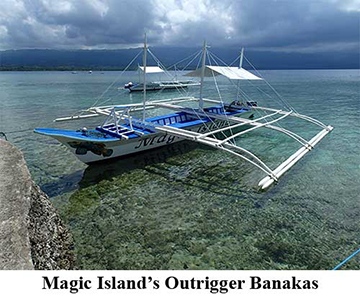 Drifting slowly
along the offshore
wall, I would see
astonishing sights.
A pink and white
soft coral crab
looked like a peppermint
with spikes.
The reef seems to be
lit by gas flames.
Beautiful pale blue social tunicates, then an ornate ghost pipefish
-- the cover girl of Reef Fish Identification
for Tropical Pacific, by Gerald Allen et al. --
along with brilliant nudibranchs, camouflaged
whip coral shrimp, and false clown, tomato and
other anemonefish. At Magic Island's twilight
mandarin-fish-mating dive, I surfaced with 190
photos of this little bundle of romance. One
swam right up to my camera, lips puckered for a
kiss. Visibility ran less than 50 feet, but no
problem for shooting the marvelous critters.
Drifting slowly
along the offshore
wall, I would see
astonishing sights.
A pink and white
soft coral crab
looked like a peppermint
with spikes.
The reef seems to be
lit by gas flames.
Beautiful pale blue social tunicates, then an ornate ghost pipefish
-- the cover girl of Reef Fish Identification
for Tropical Pacific, by Gerald Allen et al. --
along with brilliant nudibranchs, camouflaged
whip coral shrimp, and false clown, tomato and
other anemonefish. At Magic Island's twilight
mandarin-fish-mating dive, I surfaced with 190
photos of this little bundle of romance. One
swam right up to my camera, lips puckered for a
kiss. Visibility ran less than 50 feet, but no
problem for shooting the marvelous critters.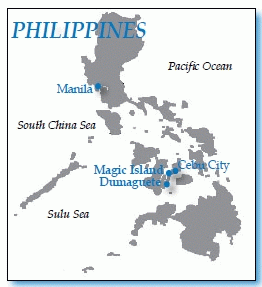 Usually, we departed for the first two dives at 8:30 a.m. after an illustrated
briefing, returned to the resort for lunch, and then headed out again at
2:30 p.m., though some folks made afternoon or evening dives off the beach. (The
shallow resort reef was usually filled with the lights of divers.) One banka was
filled with serious photographers, mostly male and some sporting $5,000 worth of
equipment, and the other banka that was mostly female divers seemed to have the
most fun. Our experienced divemasters were Dennis and Manuel, locals in their
30s and 40s who had a keen eye for small stuff. (All our divemasters and crew
smoked during breaks, downwind of us.) Jo, the Dutch dive operations manager,
spoke good English, but most of the dive staff's English skills centered on diving
vocabulary. The resort is owned by a Dutch couple living abroad and managed
by two local women.
Usually, we departed for the first two dives at 8:30 a.m. after an illustrated
briefing, returned to the resort for lunch, and then headed out again at
2:30 p.m., though some folks made afternoon or evening dives off the beach. (The
shallow resort reef was usually filled with the lights of divers.) One banka was
filled with serious photographers, mostly male and some sporting $5,000 worth of
equipment, and the other banka that was mostly female divers seemed to have the
most fun. Our experienced divemasters were Dennis and Manuel, locals in their
30s and 40s who had a keen eye for small stuff. (All our divemasters and crew
smoked during breaks, downwind of us.) Jo, the Dutch dive operations manager,
spoke good English, but most of the dive staff's English skills centered on diving
vocabulary. The resort is owned by a Dutch couple living abroad and managed
by two local women.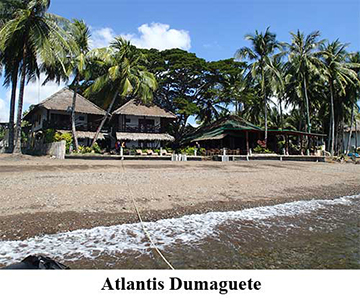 I came to think of Atlantis as a sister to the CoCo View Resort in Honduras
-- it was so clean, well run and a photographer's dream, thanks to a huge climate-
controlled camera room. A padded, U-shaped blue work surface ran waist-high
around the perimeter of the otherwise white room, with space for about 20 photographers.
There were many 110- and 220-volt outlets, even a big stack of dry
towels. Two rows of roomy open storage compartments ran under the entire work
surface. Hoses ran to compressed air nozzles for various cleaning chores. A flatscreen
TV hung at one end of the room for photo review and resort presentations.
Dumaguete's dive gear area was large enough to handle a resort full of divers. Specific dive schedules were posted daily, listing the time, boat, site, guide
name, type of dive (e.g., muck, featured creature) and diver names. Along with
many large posters of coral and critters we were likely to see, there were wooden
boxes full of laminated dive site maps and laminated photographs of marine life.
I came to think of Atlantis as a sister to the CoCo View Resort in Honduras
-- it was so clean, well run and a photographer's dream, thanks to a huge climate-
controlled camera room. A padded, U-shaped blue work surface ran waist-high
around the perimeter of the otherwise white room, with space for about 20 photographers.
There were many 110- and 220-volt outlets, even a big stack of dry
towels. Two rows of roomy open storage compartments ran under the entire work
surface. Hoses ran to compressed air nozzles for various cleaning chores. A flatscreen
TV hung at one end of the room for photo review and resort presentations.
Dumaguete's dive gear area was large enough to handle a resort full of divers. Specific dive schedules were posted daily, listing the time, boat, site, guide
name, type of dive (e.g., muck, featured creature) and diver names. Along with
many large posters of coral and critters we were likely to see, there were wooden
boxes full of laminated dive site maps and laminated photographs of marine life.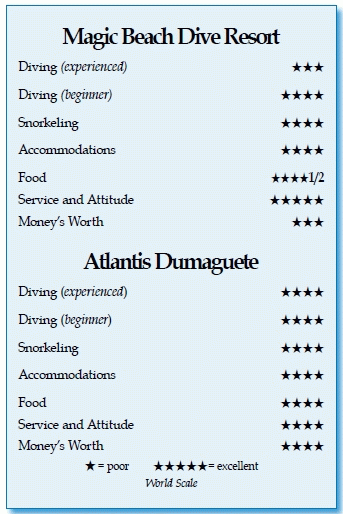 Perhaps because so many divers
might be leaving all at once, even
when using the smaller boats, the
diving at Atlantis Dumaguete had more
of a frenetic feel to it; there were
as many as five boat dives scheduled
each day, at 8:30 a.m., 10:30 a.m.,
1 p.m. and 4 p.m. We usually kept
the same guide throughout the day.
They were mainly young men in their
20s and early 30s; all were friendly
and enjoyed pointing out critters and
anything unusual to anyone who wanted
to take advantage of their expertise.
I usually dived at least 65 minutes,
often without a buddy or a gripe.
Perhaps because so many divers
might be leaving all at once, even
when using the smaller boats, the
diving at Atlantis Dumaguete had more
of a frenetic feel to it; there were
as many as five boat dives scheduled
each day, at 8:30 a.m., 10:30 a.m.,
1 p.m. and 4 p.m. We usually kept
the same guide throughout the day.
They were mainly young men in their
20s and early 30s; all were friendly
and enjoyed pointing out critters and
anything unusual to anyone who wanted
to take advantage of their expertise.
I usually dived at least 65 minutes,
often without a buddy or a gripe.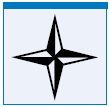 Divers Compass: My total cost for the two-resort package,
including diving, meals and transfers was $3,499 (approximately
$1,400 for Magic Island, $2,100 for Atlantis Dumaguete); for
a non-diver, the total was $2,445 . . . The round-trip flight
to Cebu from a major Midwest airport cost me $1,075; I checked
four bags, each less than 50 pounds, with no charge by Korean
Air . . . Both resorts included everyone in our tip envelope,
from divemasters to maids, and a 10 percent cash tip was recommended;
Magic Island has a surcharge for using a credit card . .
. Reef protection program fees were $35 at Magic Island, and the Kawasan trip
was $27.50; at Atlantis, the marine park fee was $90 for five days, and nitrox
was $100 for four days . . . Both resorts offered free WI-FI, hair dryers and
safe deposit boxes . . . No immunizations were necessary . . .Both resorts used
cell phones on their smaller boats, which carried oxygen and first-aid kits for
emergencies, but there were no life jackets on Magic Island's bankas. . . Both
resorts had plenty of bottled and purified water and "healthy choice" breakfast
foods, and they accommodated gluten-free and other special dietary requests
. . . Throughout my two-week trip, both air and water temperatures hovered in
the low 80s, visibility was in the 35-foot range, and divers' ages ranged from
40 to 70 . . . Websites: Magic Island Resort -
Divers Compass: My total cost for the two-resort package,
including diving, meals and transfers was $3,499 (approximately
$1,400 for Magic Island, $2,100 for Atlantis Dumaguete); for
a non-diver, the total was $2,445 . . . The round-trip flight
to Cebu from a major Midwest airport cost me $1,075; I checked
four bags, each less than 50 pounds, with no charge by Korean
Air . . . Both resorts included everyone in our tip envelope,
from divemasters to maids, and a 10 percent cash tip was recommended;
Magic Island has a surcharge for using a credit card . .
. Reef protection program fees were $35 at Magic Island, and the Kawasan trip
was $27.50; at Atlantis, the marine park fee was $90 for five days, and nitrox
was $100 for four days . . . Both resorts offered free WI-FI, hair dryers and
safe deposit boxes . . . No immunizations were necessary . . .Both resorts used
cell phones on their smaller boats, which carried oxygen and first-aid kits for
emergencies, but there were no life jackets on Magic Island's bankas. . . Both
resorts had plenty of bottled and purified water and "healthy choice" breakfast
foods, and they accommodated gluten-free and other special dietary requests
. . . Throughout my two-week trip, both air and water temperatures hovered in
the low 80s, visibility was in the 35-foot range, and divers' ages ranged from
40 to 70 . . . Websites: Magic Island Resort - 